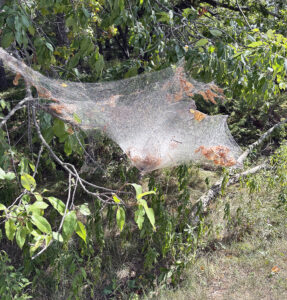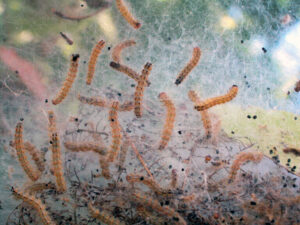
Fall webworms form a tent on a tree at Kohler-Andrae State Park in September 2025. / Photo Credit: Wisconsin DNR
By Bill McNee, DNR Forest Health specialist, Oshkosh
Bill.McNee@wisconsin.gov, 920-360-0942
The native insect known as fall webworm (Hyphantria cunea) has been generating calls and emails from curious property owners over the past few weeks.
The caterpillars don’t draw much attention on their own; instead, what catches the eye at this time of year are the large webs (or “tents”) that they create on the tips of tree branches.
These insects make their nests in late summer and early fall, when trees often have already started to shut down for the season, so any impact on tree health is likely to be minimal. Because of that, there is generally no need to take action to remove the nests and caterpillars. Wind and rain will usually break up the webs within a few months.

Fall webworms feed inside a tent. Thanks mostly to the timing of their feeding cycle (in the fall), the insect is generally not a threat to tree health. / Photo Credit: Wisconsin DNR
Property owners who want to remove a visually undesirable nest can break it up with a stick and spray insecticide, break it up and leave the caterpillars exposed to natural enemies or put on rubber gloves and drown the nest in a bucket of soapy water. There is no need to prune the branch off the tree.
Take note: These caterpillars are a different species from other insects known as the eastern tent caterpillar, forest tent caterpillar or spongy moth. Those caterpillars emerge in spring; each can cause substantial damage to trees.
